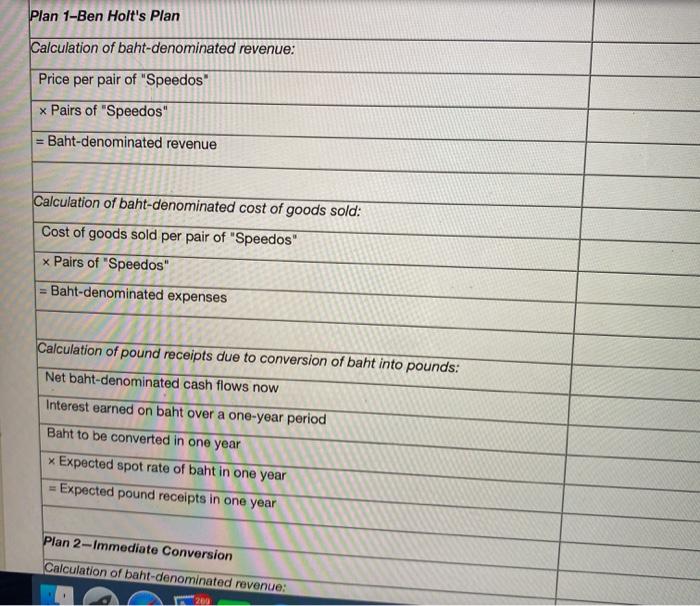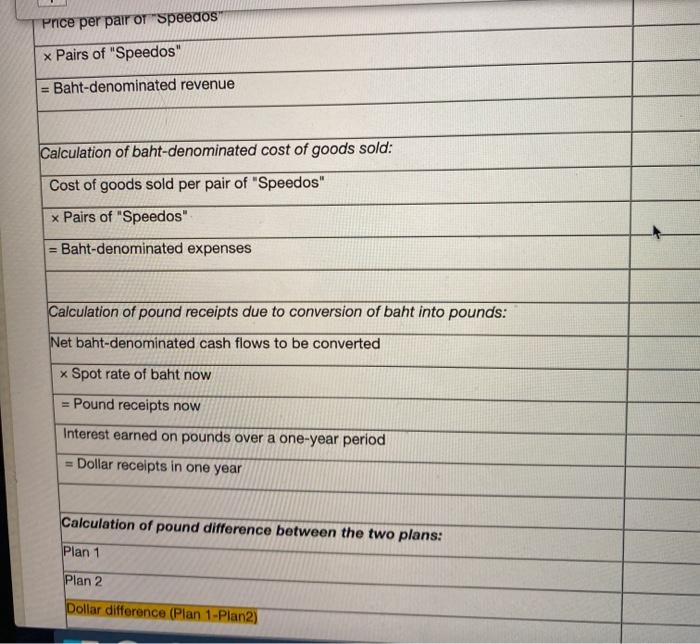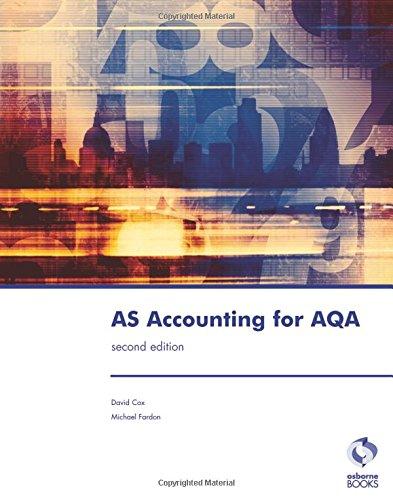1 points Save Ane As a financial analyst for Blades plc you are reasonably satisfied with Blades' current setup of exporting Speedos" (roller blades) to Thailand. Due to the unique arrangement with Blades primary customer in Thailand, forecasting the revenue to be generated there is a relatively easy task. Specifically, your customer has agreed to purchase 129,749 pairs of Speedos annually, for a period of three years, at a price of THB3,135 (THB - Thai baht) per pair. The current direct quotation of the pound-baht exchange rate is 0.016 The cost of goods sold incurred in Thailand (due to imports of the rubber and plastic components from Thailand) runs at approximately THB2,057 per pair of Speedos, but Blades Currently only imports materials sufficient to manufacture about 63.827 pairs of Speedos. Blades' primary reasons for using a Thal supplier are the high quality of the components and the low cost, which has been facilitated by a continuing depreciation of the Thai baht against the pound. If the pound cost of buying components becomes more expensive in Thailand than in the United Kingdom, Blades is contemplating providing its UK Supplier with the additional business Your plan is quite simple: Blades is currently using its Thal-denominated revenues to cover the cost of goods sold incurred there. During the last year, excess revenue was converted to pounds at the prevailing exchange rate. Although your cost of goods sold is not fixed contractually as the Thai revenues are, you expect them to remain relatively constant in the near futuro. Consequently, the baht-denominated cash inflows are fairly predictable each year because the Thal customer has committed to the purchase of 129,749 pairs of Speedos at a fixed price. The excess pound revenue resulting from the conversion of baht is used either to support the UK production of Speedos if needed or to invest in the United Kingdom Specifically, the revenues are used to cover cost of goods sold in the UK manufacturing plant Ben Holt, Blades finance director, notices that Thailand's interest rates are approximately 15 percent versus 8 percent in the United Kingdom). You interpret the high interest rates in Thailand as an indication of the uncertainty resulting from Thailand's unstable economy. Holtasks you to assess the feasibility of investing Blades excess funds from Thailand operations in Thailand at an interest rate of 15 percent. After you express your opposition to his plan, Holtasks you to detail the reasons in a detailed report Construct a spreadsheet to compare the cash flows resulting from two plans. Under the first plan, net baht-denominated cash flows (received today will be invested in Thailand at 15 percent for a one-year period, after which the baht will be converted to pounds. The expected spot rate for the baht in one year is about 20.0147 (Ben Holt's plan). Under the second plan, net baht-denominated cash flows are converted to pounds immediately and invested in the United Kingdom for one year at 8 percent. For this question, assume that all baht- denominated cash flows are due today. Does Holt's plan seem superior in terms of pound cash flows available after one year? Compare the choice of investing the funds versus using the funds to provide needed financing to the firm. As you final answer type in the dollar difference between Plan 1 and Plan 2 Plan 1-Ben Holt's Plan Calculation of baht-denominated revenue: Price per pair of "Speedos" * Pairs of "Speedos" Baht-denominated revenue Calculation of baht-denominated cost of goods sold: Cost of goods sold per pair of "Speedos x Pairs of "Speedos" Baht-denominated expenses Calculation of pound receipts due to conversion of baht into pounds: Net baht-denominated cash flows now Interest earned on baht over a one-year period Baht to be converted in one year x Expected spot rate of baht in one year Expected pound receipts in one year Plan 2-Immediate Conversion Calculation of baht-denominated revenue: Price per pair or "Speedos * Pairs of "Speedos" Baht-denominated revenue Calculation of baht-denominated cost of goods sold: Cost of goods sold per pair of "Speedos" * Pairs of "Speedos" = Baht-denominated expenses Calculation of pound receipts due to conversion of baht into pounds: Net baht-denominated cash flows to be converted x Spot rate of baht now = Pound receipts now Interest earned on pounds over a one-year period = Dollar receipts in one year Calculation of pound difference between the two plans: Plan 1 Plan 2 Dollar difference (Plan 1-Plan2) 1 points Save Ane As a financial analyst for Blades plc you are reasonably satisfied with Blades' current setup of exporting Speedos" (roller blades) to Thailand. Due to the unique arrangement with Blades primary customer in Thailand, forecasting the revenue to be generated there is a relatively easy task. Specifically, your customer has agreed to purchase 129,749 pairs of Speedos annually, for a period of three years, at a price of THB3,135 (THB - Thai baht) per pair. The current direct quotation of the pound-baht exchange rate is 0.016 The cost of goods sold incurred in Thailand (due to imports of the rubber and plastic components from Thailand) runs at approximately THB2,057 per pair of Speedos, but Blades Currently only imports materials sufficient to manufacture about 63.827 pairs of Speedos. Blades' primary reasons for using a Thal supplier are the high quality of the components and the low cost, which has been facilitated by a continuing depreciation of the Thai baht against the pound. If the pound cost of buying components becomes more expensive in Thailand than in the United Kingdom, Blades is contemplating providing its UK Supplier with the additional business Your plan is quite simple: Blades is currently using its Thal-denominated revenues to cover the cost of goods sold incurred there. During the last year, excess revenue was converted to pounds at the prevailing exchange rate. Although your cost of goods sold is not fixed contractually as the Thai revenues are, you expect them to remain relatively constant in the near futuro. Consequently, the baht-denominated cash inflows are fairly predictable each year because the Thal customer has committed to the purchase of 129,749 pairs of Speedos at a fixed price. The excess pound revenue resulting from the conversion of baht is used either to support the UK production of Speedos if needed or to invest in the United Kingdom Specifically, the revenues are used to cover cost of goods sold in the UK manufacturing plant Ben Holt, Blades finance director, notices that Thailand's interest rates are approximately 15 percent versus 8 percent in the United Kingdom). You interpret the high interest rates in Thailand as an indication of the uncertainty resulting from Thailand's unstable economy. Holtasks you to assess the feasibility of investing Blades excess funds from Thailand operations in Thailand at an interest rate of 15 percent. After you express your opposition to his plan, Holtasks you to detail the reasons in a detailed report Construct a spreadsheet to compare the cash flows resulting from two plans. Under the first plan, net baht-denominated cash flows (received today will be invested in Thailand at 15 percent for a one-year period, after which the baht will be converted to pounds. The expected spot rate for the baht in one year is about 20.0147 (Ben Holt's plan). Under the second plan, net baht-denominated cash flows are converted to pounds immediately and invested in the United Kingdom for one year at 8 percent. For this question, assume that all baht- denominated cash flows are due today. Does Holt's plan seem superior in terms of pound cash flows available after one year? Compare the choice of investing the funds versus using the funds to provide needed financing to the firm. As you final answer type in the dollar difference between Plan 1 and Plan 2 Plan 1-Ben Holt's Plan Calculation of baht-denominated revenue: Price per pair of "Speedos" * Pairs of "Speedos" Baht-denominated revenue Calculation of baht-denominated cost of goods sold: Cost of goods sold per pair of "Speedos x Pairs of "Speedos" Baht-denominated expenses Calculation of pound receipts due to conversion of baht into pounds: Net baht-denominated cash flows now Interest earned on baht over a one-year period Baht to be converted in one year x Expected spot rate of baht in one year Expected pound receipts in one year Plan 2-Immediate Conversion Calculation of baht-denominated revenue: Price per pair or "Speedos * Pairs of "Speedos" Baht-denominated revenue Calculation of baht-denominated cost of goods sold: Cost of goods sold per pair of "Speedos" * Pairs of "Speedos" = Baht-denominated expenses Calculation of pound receipts due to conversion of baht into pounds: Net baht-denominated cash flows to be converted x Spot rate of baht now = Pound receipts now Interest earned on pounds over a one-year period = Dollar receipts in one year Calculation of pound difference between the two plans: Plan 1 Plan 2 Dollar difference (Plan 1-Plan2)









